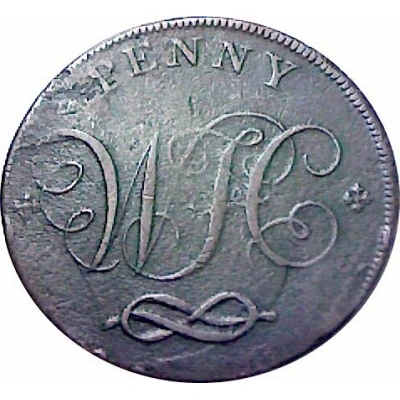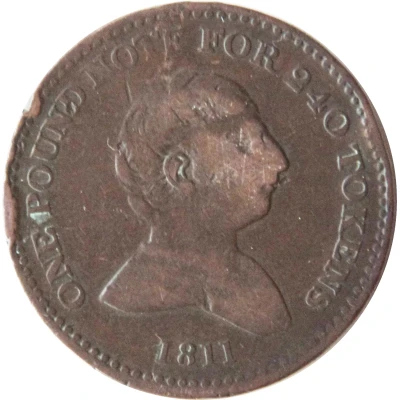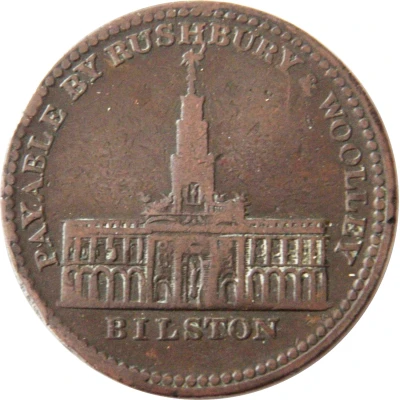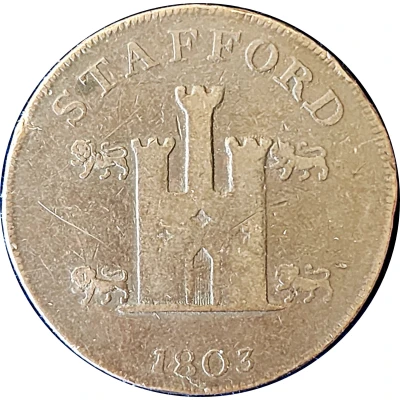
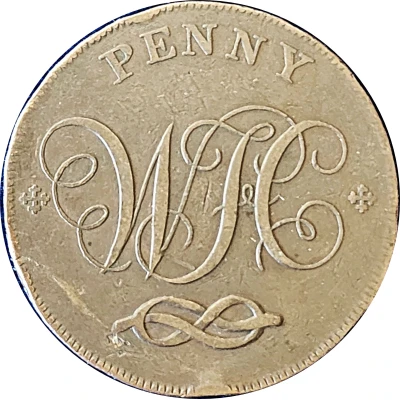

© Dave's Coins
1 Penny Staffordshire - Stafford / W. Horton
1803 year| Copper | 19 g | 35 mm |
| Issuer | United Kingdom (United Kingdom, British Overseas Territories and Crown Dependencies) |
|---|---|
| King | George III (1760-1820) |
| Type | Token |
| Year | 1803 |
| Value | 1 Penny (1⁄240) |
| Currency | Currency tokens (1798-1816) |
| Composition | Copper |
| Weight | 19 g |
| Diameter | 35 mm |
| Thickness | 2 mm |
| Shape | Round |
| Technique | Milled |
| Orientation | Coin alignment ↑↓ |
| Demonetized | 1817 |
| Updated | 2024-10-09 |
| Numista | N#375700 |
|---|---|
| Rarity index | 94% |
Reverse
A large central cypher W H in ornamental script characters, with a small a cross crosslet on either side, a flourish intended for a Staffordshire knot (incorrectly rendered) below, toothed border.
Script: Latin
Lettering:
PENNY
+ W H +
Engraver: P. Wyon
Edge
Plain with divided lettering and four dots
Lettering: PAYABLE BY HORTON AND COMPANY · · · ·
Comment
The cypher is the initial letters of William Horton, a boot and shoe manufacturer in Stafford, and a member of the town council. The obverse is supposed to present the armorial bearings of Stafford, but Debrett states that the town Seal shows a fish naiant instead of a lion in base, and the castle entrance appears portcullised with the gates thrown open. The Stafford knot, represented by the flourish beneath the cypher, is the badge of the Stafford family, but it is incorrectly rendered on the token.Horton and Co. also issued a penny piece in 1801 with the same designs, but with the change in date. The 1801 and 1803 Stafford tokens were issued in defiance of the Act of Parliament in 1797 forbidding the striking and issuing of commercial coins, to support the regal copper issues of 1797 and 1799.
Token: Great Britain Conder Stafford 1797 to 1803
A man named James Conder undertook the somewhat daunting task of identifying, organizing, and cataloging a large set of privately issued tokens used in Great Britain during the late 1700's and early 1800's. There were not enough regular government-issued coins to support commerce in sparsely populated regions, so various individuals took it upon themselves to produce tokens.
Interesting fact
One interesting fact about the Token 1 Penny (Staffordshire - Stafford / W. Horton) 1803 from United Kingdom is that it was issued during a time when there was a severe shortage of official currency in circulation, leading to the use of private token coins like this one as a substitute for official currency.

